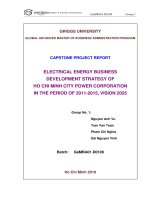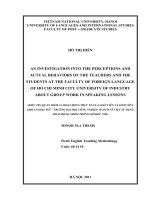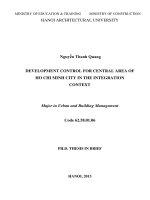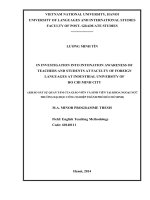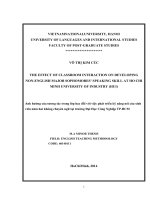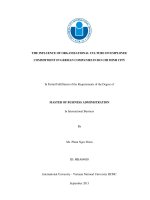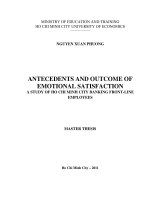Determinants of households expenditure on english language education the case of ho chi minh city
Bạn đang xem bản rút gọn của tài liệu. Xem và tải ngay bản đầy đủ của tài liệu tại đây (1.98 MB, 80 trang )
UNIVERSITY OF ECONOMICS
INSTITUTE OF SOCIAL STUDIES
HO CHI MINH CITY
THE HAGUE
VIETNAM
THE NETHERLANDS
VIETNAM – THE NETHERLANDS PROGRAMME FOR M.A IN
DEVELOPMENT ECONOMICS
DETERMINANTS OF HOUSEHOLD
EXPENDITURE ON ENGLISH-LANGUAGE
EDUCATION: THE CASE OF HOCHIMINH
CITY
MASTER OF ARTS IN DEVELOPMENT ECONOMICS
By
LUU THI KIEU OANH
Academic Supervisor
Dr. PHAM KHANH NAM
HO CHI MINH CITY, 2013
CERTIFICATION
“I certify that the substance of this thesis has not already been submitted for any degree
and has not been currently submitted for any other degree.
I certify that to the best of my knowledge and help received in preparing this thesis and all
used sources have acknowledged in this dissertation”.
LUU THI KIEU OANH
Date: … Dec 2013
i
ACKNOWLEGMENTS
Firstly, I would like to thank so much to Vietnam – The Netherlands programme for
Master of Art in Development Economics where I have been studying useful knowledge.
I would like to express my deep gratitude to my academic supervisor, Dr. Pham
Khanh Nam for his great supports, advices and encouragements during my thesis
completion.
I thank so much for all lecturers because of their valuable supports as well as all my
family, my friends because of their helps and encouragements during my study.
One again, I am grateful to all of you. Thank you very much!
LUU THI KIEU OANH
ii
ABSTRACT
This study attempts to investigate household’s expenditure on English education for
primary school children using the surveyed data from 267 randomly collected households
in Ho Chi Minh City. As a result, the current payment for English education of household
in Ho Chi Minh City plays an important role in total expenditure for education. It takes up
61.4% of basic education in average. Compared with household’s total income and total
expenditure, it makes up 4.7% and 6.7% of total income and total expenditure,
respectively. The study also found that total income, total expenditure, current payment for
extra education, education level of wife and household own a house has a positive
relationship with English education expenditure.
Keywords: English education, expenditure, income
iii
TABLE OF CONTENTS
CERTIFICATION .............................................................................................................................. i
ACKNOWLEGMENTS .................................................................................................................... ii
ABSTRACT ..................................................................................................................................... iii
LIST OF FIGURES .......................................................................................................................... vi
LIST OF TABLES ........................................................................................................................... vii
ABBREVIATIONS ........................................................................................................................ viii
CHAPTER 1: INTRODUCTION ...................................................................................................... 1
1.1.
Problem Statements ............................................................................................................ 1
1.2.
Research Objectives ............................................................................................................ 2
1.3.
Research Questions ............................................................................................................. 3
1.4.
Research methodology ........................................................................................................ 3
1.5.
The structure of the study ................................................................................................... 3
CHAPTER 2: LITERATURE REVIEW ........................................................................................... 5
2.1.
Theoretical literature ........................................................................................................... 5
Theory of Education expenditure: Education production function ........................................... 5
Theory of household production function .................................................................................. 6
Theory of income elasticity of educational expenditure: ........................................................... 6
2.2.
Empirical literature ............................................................................................................. 7
2.3.
Conceptual framework ...................................................................................................... 13
CHAPTER 3: RESEARCH METHODOLOGY ............................................................................. 15
3.1.
Sampling strategy and data collection .............................................................................. 15
3.2.
Variables’ measurement and explanation ......................................................................... 15
3.3.
Model specification ........................................................................................................... 23
CHAPTER 4: EMPIRICAL ANALYSIS RESULTS ..................................................................... 28
4.1.
General information of the Household’s characteristic in HCM City .............................. 28
4.2.
General information of English education in Vietnam ..................................................... 29
4.3.
Importance of English expenditure in household’s decision ............................................ 31
4.4.
Empirical analysis results ................................................................................................. 32
iv
4.4.1.
Descriptive statistics .................................................................................................. 32
4.4.2.
Regression results ...................................................................................................... 40
CHAPTER 5: CONCLUSIONS, RECOMMENDATIONS AND LIMITATIONS ....................... 46
5.1.
Conclusions and recommendations................................................................................... 46
5.1.1. Conclusion ........................................................................................................................ 46
5.1.2. Recommendations ............................................................................................................. 46
5.2.
Limitations ........................................................................................................................ 47
REFERENCES ................................................................................................................................ 49
APPENDIX ..................................................................................................................................... 52
v
LIST OF FIGURES
Figure 2.1 Analytical framework for the impact explanatory variable on English education
expenditure.......................................................................................................................... 14
Figure 4.1 The education level of the parents in Ho Chi Minh City – Author’s survey 2013 .
............................................................................................................................................. 29
Figure 4.2 The education level of the parents in Ho Chi Minh City – VHLSS 2010 ........ 29
Figure 4.3 The distribution of current English education expenditure in basic education,
total income and total expenditure ...................................................................................... 32
Figure 4.4 Histogram graphic of the current payment for English education in Ho Chi
Minh City ............................................................................................................................ 33
Figure 4.5 Histogram graphic of the dummy variable of current payment for English
education in Ho Chi Minh City .......................................................................................... 34
Figure 4.6 Household’s total income distribution in Ho Chi Minh City. ........................... 35
vi
LIST OF TABLES
Table 3.1 Variable description and expected sign for Model 1 .......................................... 26
Table 4.1 The development of number of foreign language center through the years ....... 31
Table 4.2 Summary statistic of variables ............................................................................ 37
Table 4.3 The relationship of total income and current payment for English education ... 39
Table 4.4 The relationship of household’s total expenditure and current payment for
English education ................................................................................................................ 39
Table 4.5 The results of the models .................................................................................... 40
vii
ABBREVIATIONS
Ageh
Age of husband
Agew
Age of wife
Cpe
Current payment for English education
Cpec
Current payment for extra class
Eduh
Education level of husband
Eduw
Education level of wife
Engh
English level of husband
Engw
English level of wife
Genderhh
Gender of household’s head
MOET
Ministry of Education and Training
Nrofchildren
Number of children
Ownh
Household own a house
Soeh
Sector of employment of husband
Soew
Sector of employment of wife
Totalexp
Household’s total expenditure
Wifeworking
Wife is working
VHLSS
Vietnam Household Living Standard Survey
viii
CHAPTER 1: INTRODUCTION
1.1.
Problem Statements
Foreign language currently is a prominent issue in worldwide education and society.
With the rapid development of information and communication technologies, through
computer systems and networks, people between nations are closer and closer together
understand each other through intermediate language that commonly is the English. Most
of the knowledge such as books, academic papers, documentation in economy, science and
technology, culture and society... are mainly written in English and widely circulated on
the global network. Bolton (2006) likened the English expansion as the most rapid spread
language all over the world. In addition, the communication between different languages
people through this common language which can understand and move toward the agreed
long-term good cooperation. In reality, English is rated as the most used and common
speaking language in the world with more than 1,226 million users in 2003 and spread on
75 countries on the world according to Crystal (2003). Graddol (2008) figures that there
are more and more people learning English as a second language and it will nearly get big
amount of two billions next ten years. There was also a replacement of English as a school
subject instead of Russian from the participation of some Eastern European countries
(Modiano, 2006). Since educating English was identified as an important factor
indispensable, it should be considered by government investment, according to Nergis,
(2011)In some developing countries such as Turkey, they recognize that “the only way to
bring Turkish up to the level of the communicational requirements of the modern world is
through the interaction of knowledge of English with the derivational convenience
provided by the Turkish language reform.”
In Vietnam, Thinh (2006) observed that in the past ten years before the joining
WTO, the spread of English has facing with an unpredicted speed in Vietnam. The
statistics shows that among the foreign language learner, the English learner takes up more
than 90% of that volume. While other languages such as Chinese, Japanese, French,
1
Korean, and German shares the rest of volume with smaller classes. There was the
emergence of requiring English for job seeking and the overseas studies which impulse
over 900,000 learners came to the language centers in Ho Chi Minh city. Moreover,
teaching English program was also started at the universities, high schools, government
agencies at that period time. After the accession to the WTO accompanied with open
policy has attracted a large number of foreign investors to enter the domestic market with
small and large projects and the huge investments. To meet the sufficient qualified labor
force and ability to work with foreign partners, to communicate and understand the partner
is an important issue emerged at the present time. Therefore, learning language is an urgent
issue arises in the context of the integration of the international economic today.
Recognizing the need for English language development, many parents are planning for
their children a foundation of language, namely English, since they start school.
For these reasons, this study is to investigate how important parents see the role of
English education by identifying parents’ expenditure on educating English language of
their children at starting school age (primary school) in Ho Chi Minh city. Then, it helps to
clarify the important role of English language education in general and English in
particular for the development of the country which should be concerned and invested by
both the individual investor and the government in Vietnam.
1.2.
Research Objectives
General objective: To investigate household’s expenditure on English language
education for children at starting school age (primary school)
Specific objectives:
(1) To identify the importance of English language education in a household’s decision
(2) To identify the determinants of household’s expenditure on English education for
primary school children in Ho Chi Minh City.
2
1.3.
Research Questions
In this study, we attempt to answer the question: Do parent’s income, parent working
environment, parent’s English level and other demographic issue (age, gender, marital
status, location, home ownership and employment status…) impact on the expenditure to
English education for their children? If yes, how much does it contribute to?
1.4.
Research methodology
This study bases on Pritchett and Filmer (1999)’s theory of education expenditure.
Empirically, it combines both descriptive statistics and regression analysis to analyze the
importance of English education and its expenditure determinants. First of all, descriptive
statistic is used to analyse the overall view of English education expenditure of the
households in Ho Chi Minh City based on their total income, total expenditure and some of
the characteristics of the Ho Chi Minh’s household. Second, the ordinary least square
(OLS) is employed to figure out the influent factors of English language expenditure on the
children at primary school age. Third, the logit regression is applied to investigate whether
or not these determinants affect on the household’s decision to spend for their English
language education. Fourth, the ordered logit regression are applied to settle the problem
when the dependent variable, in this case is the English education expenditure, is not a
continuous but it is ordered. In this study, the answer the expenditure on English is ranked
from zero to sixth level which is not equal between these levels.
1.5.
The structure of the study
This study is basically divided into five chapters and here is the first chapter of
introduction. Following the first chapter, chapter 2 reviews the three theories of the
education expenditure, the household production function and the income elasticity of
education expenditure. Some recent empirical researches concerning the expenditure on
education in Vietnam and around the world are also employed as the reference in this
thesis. Next, chapter 3 is about the research methodology including the way of collecting
data, the variables’ explanation and measurement as well as the model specification. The
3
chapter 4 will firstly present the overall information of the education in general and the
English education in particularly in Ho Chi Minh City. Secondly, we will discuss about the
influent factors such as parent’s total income, parent’s total expenditure, parent’s education
level and English level, and some of the household’s demographic characteristics which
will affect on the English education expense for their children at the primary school age or
not?
4
CHAPTER 2: LITERATURE REVIEW
2.1.
Theoretical literature
In order to comprehend the purpose of this research, we first discuss education expenditure
theories.
Theory of Education expenditure: Education production function
Pritchett and Filmer (1999) present a theory of education expenditure via the
education production function. Their theoretical literature shows that a “production
function” is an explanation of how much the amount of each input contributes to the
amount of output. Then, they apply it into the function of education. In particularly, the
education production function will study the causal effect of school inputs and nonschool
inputs on the children outcome. The school inputs, for e.g. the education level of teachers,
the size of class, teacher experience, the tool supports education as textbooks would
influence the children achievement score. Whiles, the non-school inputs such as the
family’s factors, environmental factors and children congenital ability would also affect the
outcome of children.
The specific function of education production is defined as below:
Where Cit presents for children’s output, Sit presents for school inputs, Fit denotes the nonschool inputs (family inputs) and Ii is the children’s congenital ability. In this case, they use
a general term to represent approximately the congenital variable that is fixed student
contribution. Because there is no data sets which can measure the nonfigurative variable
like congenital ability.
5
Theory of household production function
Both Becker (1965) and Muth (1966) raise a household production function model
to explain that commodities which are purchased on market simultaneously are the input of
the household production. In particularly, they employ the production function of child
health which can be shown as below:
H = Γ (Yj, Ik, µ),
Whereas, Yj are other good affect child’s health; Ik present for health input and µ is the
family-specific health endowments such as genetic characteristics or environmental factors
Later on, from this household production function, they developed household’s
reduced-form demand function:
Zt = St ( p, F, µ)
Whereas, p is the price of goods or services; F is the exogenous income and µ is the family
specific endowment.
Learning from this theory, in order to measure the household expenditure on
English language education, supposes that education is also a kind of goods which is
consumed by household. Hence, we test the factors which can affect the household
production function such as the household’s income, the family specific endowment
factors and many others demographic factors. More details, the family specific endowment
using in this case are English level of the parents (a kind of issue concern genetic
characteristic) and working environment of parents (an environmental factor).
Theory of income elasticity of educational expenditure:
According to Benson (1961), the level of household income has direct effect on the
educational expenditure which is measured by the income elasticity of education. There are
three levels of income divided into low, middle and high income. In detail, the households
at low and high income are expected to have the amount of income elasticity of education
from zero to one. In contrast, a middle income household has value of income elasticity
6
higher than one. This explains clearly that the middle income families have the tendency to
concern about their children’s education and they spend more money for them than the
other class. For the low income families, they less concern about the quality of schooling
so that their education expenditure are predicted increase less than their total income.
Use the Lorenz curve to measure the distribution of income to the education
expenditure. The form of income elasticity of educational expenditure as follows:
Whereas Ei is the elasticity of income vi(x) is the Engel function of the i expenditure items.
2.2.
Empirical literature
2.2.1. Dependent variable
In this research, we attempt to explain the dependent variable that is the expenditure
of English language education. In the study of English-language proficiency among U.S
immigrants, Espenshade (1997) consider English language education as a human capital
investment. It concerns the expenses for the investment and the relevant expected return
which spenders would response differently. Consequently, expenditure on English is a
diversified and complex variable so that it could not be able to interpret by one
independent variable. There are not many studies regarding this field. Mainly works did
study the expenditure of education in general but not in the detail of educating English
language. According to (Kanellopoulos (1997), Tansel (2006) and Donkoh (2011), the
disbursement of education is determined essentially by household income, household
expenditure, parent’s schooling, sector of employment, employment status, age of
household head, gender of household head, mother work or not, household size, local and
own the house or not. Learning from these previous studies of education expenditure, we
employ the above independent variables and develop the new model to figure out the
7
determinants of spending on English language education. We will talk about the specific
model later in the methodology section.
2.2.2. Independent variables
Household’s income
The impact of household’s income on education expenditure is precisely existed. It
is clearly that once the households get wealthier they would like to enhance their living
standards. Education is one of the important standards which are considered to invest for
their new generation in priority, Donkoh (2011). Both Glewwe (1999), Tansel and Bircan
(2006) and Donkoh and Amikuzuno (2011) found that when the household’s income rise
they are more willing to pay for the private tutoring.
To evaluate the impact of income on education expenditure, the income educational
expenditure elasticity of the household is employed as a proxy. Most of the papers use the
Tobit model to valuate this income elasticity value (we will talk about the model later in
the methodology section). In particular, Hashimoto and Heath (1995) discovered the
highest income elasticity of education expenditure relates to the middle income level of
household and the value is higher than one; while it ranges from zero to one for lower and
higher income class. This means that the rise in education expenditure of the middle
income household is higher than other class as long as their income increases a unit. And
the lower and higher income class seems regardless the quality of their children’s
education. Kanellopoulos and Psacharopoulos (1997) figured out the income educational
expenditure elasticity in case of Greece is 3.18. Whereas, Hashimoto and Heath (1995)
come up with different value 2.35 in Japan. However, they both conclude that the
education expenditure is a kind of luxury good. But this is not true in the conclusion of
Tansel and Bircan (2006) they found the unitary elasticity of income on education demand.
Hence, they conclude education is not a luxury good in the case of Turkey as it is
discovery in some researches.
Household total expenditure
8
In this research, we analyze the issue regards the English language education, an
informal educational activity or also named as a private tutoring. According to Stevenson
and Baker (1992), the household tend to expense more money for investing in the informal
educational activities as long as they expect their children to get higher education and
successful career. For this reason, it is easily to find that the probability of expense for
educational activities rises in accordance with the expenditure level of the households. The
tutor fee spending for extra educational activities is about 11.2% of total expenditure of a
family. Among them, the expenses for foreign languages education take more than sixtythree percents of their total expenditure, a dominated devote amount for education,
Kanellopoulos and Psacharopoulos (1997). Their point of view is clearly that parents’
spending for their children’s education increase sharply along with their total expenses.
In addition, there are some other outstanding issues concerning the way of choosing
variable so that it can avoid the simultaneous problem. Some authors argued the
simultaneous between total expense and individual expense would result in the bias. And
they suggest use instrumental variable such as household’s income to settle this bias,
Liviatan (1961).
In order to do that, Tansel and Bircan (2006) attempt to test the
exogeneity of total expense of a household. This test is named as Tobit model, defined by
Smith and Blundell (1986) and include two steps. First is the regression of total spending
on household’s income. Second is using the residuals from the regression one and put it in
the Tobit model of extra education spending to test the significance. As a result, they found
the significance at one percent reject the null hypothesis. Hence, they use the total expense
of a household as an explanatory variable instead of using household’s income variable.
Parent’s education
There are many studies employ this independent variable to explain its relationship
of education expenditure such as Knight and Shi (1996), Kanellopoulos and
Psacharopoulos (1997), Tansel and Bircan (2006), Qian and Smyth (2011) and Donkoh
and Amikuzuno (2011). Nearly all of them found the positive impact of parental education
to their spending for children’s education. In there, Knight and Shi (1996) point out two
9
main findings: “(1) parent’s educational attainment is the most important factor influencing
children’s education expenditure. (2) Father’s education is more important factor than
mother’s education”. Kanellopoulos and Psacharopoulos (1997) found the significance of
parental education on the household expenditure on their children’s education. The
households where the head has higher education range are more willing to devote more
income for education. Specifically, it is approximately 2.2% increase in probability of
family agree to expense for education when a household head get one more year of
education.
Especially, some authors emphasize the important role of mother’s education in
making the decision. Qian and Smyth (2011) said “the household where mothers have
senior secondary school or college education are likely to spend more on education”.
Donkoh and Amikuzuno (2011) claims it connects to the fact that the persons who are well
educated would be able and please to give their son/daughter the same opportunity and
expect them got higher education level.
Sector of employment:
Either Kanellopoulos and Psacharopoulos (1997) or Andreou (2012) come up with
the similar conclusion of this concerned that the households which are working in the
private sector have tendencies to finance more for their son/daughter’s education.
Recently, Qian and Smyth (2011) also found that “household where fathers are working in
professional occupations, are likely to spend more on education”. So, the private sector is
the key determinants of in their research regarding the working environment of the
household head.
Employment status
According to Kanellopoulos and Psacharopoulos (1997), Donkoh and Amikuzuno
(2011), the occupation of the parents could also affect the willingness of a household to
invest in children’s education. There are two schools of thought about this issue. One is the
occupation has a positive effect since it is supposed the lower class of household tend to
10
compensate their lack of education by spending more for your children’s education. Other
is the negative effect on their expense. The upper class parents think that education brings
a relative low value in compared with their household value. Hence, they disregard the role
of education. Nevertheless, Andreou (2012) said the occupation of parents does not affect
significantly on private spending for education.
Age of household’s head
Most of the studies employ the age of household’s head as an essential variable to
evaluate its effect on the household’s investment in education. Generally, the age of head
appeared to be negative efficiency to their choice of spending according to Kanellopoulos
and Psacharopoulos (1997), Donkoh and Amikuzuno (2011) and Andreou (2012).
Donkoh and Amikuzuno (2011) employ the age and age square variable represent
for the young and old household head. As a result, the older the household’s head, the less
willing to spend for education. They argue that the household with younger head is
considered more advanced and comprehend the long-term benefit and the role of education
in comparison with their older counterparts.
Kanellopoulos and Psacharopoulos (1997) divide this variable into six age groups:
under 25, from 25 to 34, from 35 to 44, from 45 to 54, from 55 to 64 and above 65. They
discovered that the top of spender for education belong to the group with heads from 35-44
years old. It is approximately 62.6 percents of the heads in this group are pleasure to pay.
And the probability of expenses decline after this group.
Nevertheless, Tansel and Bircan (2006) stated differently about this context. When
analyzing the demand for private tutoring expenditure in Turkey, they found that the more
accumulation of head’s age, the more willing to pay for tutoring their child. Hence, we will
test the affective trend of the household’s head age on the investment in their child’s
education expenditure.
Gender of household head
11
Likewise, we will attempt to test whether the gender would affect the household
decision on education expenditure. Learning from the empirical studies, they apply the
dummy for this variable. Some studies found the differentiation between mother and father
spending willingly on their son/daughter. And that a female head tend to expense more
than a male head. By contrast, Andreou (2012) did not find the meaning of gender on the
household’s head expenditure on education.
Household size
One of the research studies the related field in case of Vietnam, Dang (2007)
worked on “The determinants and impact of private tutoring classes in Vietnam”. He
argues that the number of children in a household is possibly an endogenous variable since
the family’s decision of their child may concern either the quantity or the quality
simultaneously. In more details, the parents would increase their investment in educating
their children as their household size is smaller. That would be a choice concerning the
quality rather than the quantity. In addition, Jelani and Tan (2012) stated the same with
Dang (2007). He reasons that an additional child causes the rise of the family expenditures
so that it would result in the less investment of parent in the education. However, in the
paper of Donkoh and Amikuzuno (2011) they emphasize the quantity aspect. As the larger
size of the household, the more probability of the parents expense for education.
Local
The authors such as Tansel and Bircan (2006) and Donkoh and Amikuzuno (2011)
found the precise link between the higher expenditure on education and the urban areas.
They all conclude that the household in urban areas tend to spend more money for
educating their child in comparison with rural counterparts. Only Andreou (2012) said the
vary household’s region does not result in different of education’s disbursement.
In particular, Donkoh and Amikuzuno (2011) states the differentiation of the
number of household expense for private education (the quantity of spending) and the
amount of money they spend (the quality of spending). Their study shows there is a larger
12
number of household agree to spend for education in the rural part than the city part. By
contrast, the concentrated city has the higher quality of education investment than the rural
part. Thus, we will have household’s location as an endogenous variable as same as the
above mention about the household age.
Household own a house
Both Kim and Lee (2002) and Donkoh and Amikuzuno (2011) claim that the
household own a house is more likely to expense for their children’s education. It is well
accepted that having a house is equivalent to the better living conditions as well as
correlated to the higher income. For these reason, they are easier to take the charges of
their son/daughter’s education.
2.3.
Conceptual framework
Overall of the above empirical literature, the study is going to test the relationship
between the private expenditure for English education and the explanation variables as the
following:
13
Figure 2.1 Analytical framework for the impact explanatory variable on English education
expenditure
PRIVATE
EXPENDITURE
for English language
Education
Income
Working
environment
English level
of Parents
Demographic
Factors
Age
Gender (dummy V)
Marital status
Location (dummy V)
Home ownership
(dummy V)
Employment status
Number of children
…
Source: Author’s analysis
14
CHAPTER 3: RESEARCH METHODOLOGY
3.1.
Sampling strategy and data collection
The study used the primary data collection by face to face survey. A questionnaire
was composed to cover the main questions which includes household’s total income,
parent’s education level and English level, career of the parent, and some other
demographic issue (age, gender, marital status). The households surveyed include those
with children at pre-primary and primary education level in Ho Chi Minh City. The
households were chosen randomly from each districts or sub districts. Households were
selected randomly by the number of house and in one random ward of the district. About
20 households were interviewed in each districts/sub-districts. The internal districts in Ho
Chi Minh City comprise district one to twelve, Tan Phu, Tan Binh, Binh Tan, Binh Thanh,
Go Vap, Phu Nhuan. The sub-districts include Binh Chanh, Hoc Mon, Cu Chi, Nha Be
whereas we excluded the Can Gio’s observation because of its low population density.
When a questioned household which has no children at the primary school age, we
ask the next house for replacement. If the next three houses have no children at our
objective age, we will leave this sample empty. Some chosen households leave the empty
answer sheet due to their private issues. Hence, some districts didn’t get enough 20
responses and finally the survey got 267 observations in total for this study. The
questionnaires table would be listed in the annex.
3.2.
Variables’ measurement and explanation
3.2.1. Current expenditure on English education
As mentioned above, the expenditure on English is a diversified and complicate
variable. It is considered as a human capital investment, Espenshade and Fu (1997). It
concerns the expenses for the investment and the relevant expected return which spenders
15
would response differently. Since there are not many studies related to the language
education expenditure, we employ factor affect the spending for general education and
then develop a new model for the case of English education expenditure. Following the
results from these researches of Kanellopoulos and Psacharopoulos (1997), Tansel and
Bircan (2006) and Donkoh and Amikuzuno (2011), this study focus on researching some
similar factors such as the household’s total income, household’s total expenditure,
parent’s schooling, sector of employment, age of household head, gender of household
head, mother work or not, household size, local and own the house or not. Then pointing
out whether or not these factors would impact on the spending manner for English
education of these household’s.
In this study, we use the current expenditure on English education to measure the
interest level of their parents to the children’s language education. It is divided into 6
levels: zero means no expenditure for English education at the present time, one means the
current expenditure is ranked from 0 to 300,000 VND, two means the current expenditure
is ranked from above 300,000 to 500,000 VND, three means the current expenditure is
ranked from above 500,000 to 1,000,000 VND, four means the current expenditure is
ranked from above 1,000,000 to 2,000,000 VND, five means the current expenditure is
ranked from above 2,000,000. These ranks are based on the average current fee of the extra
English class at school and the English center. The price is collected from ten school and
eleven English center for the beginning and pre-intermediate class for primary children.
See the list of school and English center in the appendix.
3.2.2. Household’s total income
As discussion in the previous chapter, the impact of household’s income on
education expenditure is considerable. Once the households get wealthier they tend to
enhance their living standards in which education is one of the important standards to
invest, Donkoh and Amikuzuno (2011). Both Glewwe and Desai (1999), Tansel and
Bircan (2006) and Donkoh and Amikuzuno (2011) found that when the household’s
income rise they are more willing to pay for the private tutoring. In this study, we suppose
16


